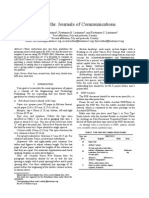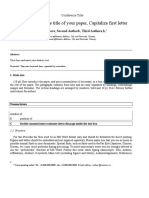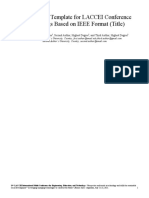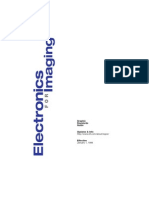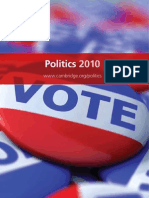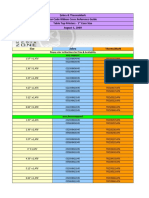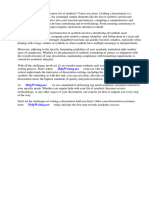ACEEE Template
ACEEE Template
Uploaded by
Abir AhmedCopyright:
Available Formats
ACEEE Template
ACEEE Template
Uploaded by
Abir AhmedCopyright
Available Formats
Share this document
Did you find this document useful?
Is this content inappropriate?
Copyright:
Available Formats
ACEEE Template
ACEEE Template
Uploaded by
Abir AhmedCopyright:
Available Formats
International Journal of Network Security, Issue. 1, Vol.
1, May 2009
Preparations of Papers for the Conference/Journal Publications of the ACEEE Press
First A. Author1, Second B. Author2, and Third C. Author2
Name of Institution/Department, City, Country Email: first.author@hostname1.org 2 Name of Institution/Department, City, Country Email: {second.author, third.author}@hostname2.org
1
AbstractThese instructions give you basic guidelines for preparing camera-ready papers for ACEEEs conference proceedings/Journal Publications. Index Termsfirst term, second term, third term, fourth term, fifth term, sixth term
Type size (pts.) 6 8 9 10 11 24
TABLE I. TYPE SIZES FOR CAMERA-READY PAPERS Appearance Regular Table captions, table superscripts Section titles, tables, table names, first letters in table captions, figure captions, footnotes, text subscripts, and superscripts References, authors biographies Authors affiliations, main text, equations, first letters in section titles Authors names Paper title Abstract Subheading
a
Bold
Italic
I. INTRODUCTION Your goal is to simulate the usual appearance of papers in a Conference Proceedings or Journal Publications of the ACEEE Press. We are requesting that you follow these guidelines as closely as possible. A. Full-Sized Camera-Ready (CR) Copy Prepare your CR paper in full-size format, on A4 paper (210 x 297 mm, 8.27 x 11.69 in). No header or footer, no page number. Type sizes and typefaces: Follow the type sizes specified in Table I. As an aid in gauging type size, 1 point is about 0.35 mm. The size of the lowercase letter j will give the point size. Times New Roman has to be the font for main text. Paper should be single spaced. Margins: top = 30mm (1.18 in), bottom, left and right = 20 mm (0.79 in). The column width is 82mm (3.23 in). The space between the two columns is 6mm (0.24 in). Paragraph indentation is 3.7 mm (0.15 in). Left- and right-justify your columns. Use tables and figures to adjust column length. On the last page of your paper, adjust the lengths of the columns so that they are equal. Use automatic hyphenation and check spelling. Digitize or paste down figures. For the Title use 24-point Times New Roman font, an initial capital letter for each word. Its paragraph description should be set so that the line spacing is single with 6-point spacing before and 6-point spacing after. Use two additional line spacings of 10 points before the beginning of the double column section, as shown above. Each major section begins with a Heading in 10 point Times New Roman font centered within the column and numbered using Roman numerals (except for ACKNOWLEDGEMENT and REFERENCES), followed by a period, two spaces, and the title using an initial capital letter for each word. The remaining letters are in SMALL CAPITALS (8 point). The paragraph description of the section heading line should be set for 12 points before
Footnotes: 8-point Times New Roman font; copyright credit, project number, corresponding author, etc.
and 6 points after. Subheadings should be 10 point, italic, left justified, and numbered with letters (A, B, ), followed by a period, two spaces, and the title using an initial capital letter for each word. The paragraph description of the subheading line should be set for 6 points before and 3 points after. For main text, paragraph spacing should be single spaced, no space between paragraphs. Paragraph indentation should be 3.7mm/0.21in, but no indentation for abstract & index terms. As always with a conversion to PDF, authors should very carefully check a printed copy. II. HELPFUL HINTS A. Figures and Tables Position figures and tables at the tops and bottoms of columns. Avoid placing them in the middle of columns. Large figures and tables may span across both columns. Leave sufficient room between the figures/tables and the main text. Figure captions should be centered below the figures; table captions should be centered above. Avoid placing figures and tables before their first mention in the text. Use the abbreviation Fig. 1, even at the beginning of a sentence. To figure axis labels, use words rather than symbols. Do not label axes only with units. Do not label axes with
International Journal of Network Security, Issue. 1, Vol. 1, May 2009
Number equations consecutively with equation numbers in parentheses flush with the right margin, as in (1). Italicize Roman symbols for quantities and variables, but not Greek symbols. Punctuate equations with commas or periods when they are part of a sentence, as in
a +b =c.
(1)
Symbols in your equation should be defined before the equation appears or immediately following. Use (1), not Eq. (1) or equation (1), except at the beginning of a sentence: Equation (1) is ... F. Other Recommendations Use either SI (MKS) or CGS as primary units. (SI units are encouraged.) If your native language is not English, try to get a native English-speaking colleague to proofread your paper. Do not add page numbers. CONCLUSIONS The authors can conclude on the topic discussed and proposed. Future enhancement can also be briefed here.
Figure 2. Note how the caption is centered in the column.
a ratio of quantities and units. Figure labels should be legible, about 9-point type. Color figures will be appearing only in online publication. All figures will be black and white graphs in print publication. B. References Number citations consecutively in square brackets [1]. Punctuation follows the bracket [2]. Use Ref. [3] or Reference [3] at the beginning of a sentence: Give all authors names; use et al. if there are six authors or more. Papers that have not been published, even if they have been submitted for publication, should be cited as unpublished [4]. Papers that have been accepted for publication should be cited as in press [5]. In a paper title, capitalize the first word and all other words except for conjunctions, prepositions less than seven letters, and prepositional phrases. For papers published in translated journals, first give the English citation, then the original foreign-language citation [6]. C. Footnotes Number footnotes separately in superscripts 1, 2, . Place the actual footnote at the bottom of the column in which it was cited, as in this column. See first page footnote as an example. D. Abbreviations and Acronyms Define abbreviations and acronyms the first time they are used in the text, even after they have been defined in the abstract. Do not use abbreviations in the title unless they are unavoidable. E. Equations Equations should be centered in the column. The paragraph description of the line containing the equation should be set for 6 points before and 6 points after.
APPENDIX A APPENDIX TITLE Appendixes, if needed, is numbered by A, B, C... Use two spaces before APPENDIX TITLE. ACKNOWLEDGMENT The authors wish to thank A, B, C. This work was supported in part by a grant from XYZ. REFERENCES
[1] G. Eason, B. Noble, and I. N. Sneddon, On certain integrals of Lipschitz-Hankel type involving products of Bessel functions, Phil. Trans. Roy. Soc. London, vol. A247, pp. 529551, April 1955. [2] J. Clerk Maxwell, A Treatise on Electricity and Magnetism, 3rd ed., vol. 2. Oxford: Clarendon, 1892, pp.6873. [3] I. S. Jacobs and C. P. Bean, Fine particles, thin films and exchange anisotropy, in Magnetism, vol. III, G. T. Rado and H. Suhl, Eds. New York: Academic, 1963, pp. 271 350. [4] K. Elissa, Title of paper if known, unpublished. [5] R. Nicole, Title of paper with only first word capitalized, J. Name Stand. Abbrev., in press. [6] Y. Yorozu, M. Hirano, K. Oka, and Y. Tagawa, Electron spectroscopy studies on magneto-optical media and plastic substrate interface, IEEE Transl. J. Magn. Japan, vol. 2, pp. 740741, August 1987 [Digests 9th Annual Conf. Magnetics Japan, p. 301, 1982]. [7] M. Young, The Technical Writer's Handbook. Mill Valley, CA: University Science, 1989.
You might also like
- Template For Assignment ReportDocument3 pagesTemplate For Assignment ReportNasir HadranNo ratings yet
- Ffta First 5.0 Design GuideDocument87 pagesFfta First 5.0 Design GuideSharlowNo ratings yet
- ACEEE TemplateDocument4 pagesACEEE Templateahmad11222No ratings yet
- Paper Title: Preparations of Papers For The Journals of The Academy PublisherDocument3 pagesPaper Title: Preparations of Papers For The Journals of The Academy PublisheranandsilverNo ratings yet
- Paper Title: Please Make Sure The Length of The Title Within Four LinesDocument3 pagesPaper Title: Please Make Sure The Length of The Title Within Four LinesDewi AnggitaNo ratings yet
- Paper Title:: Abstract-These Instructions Give You Basic Guidelines ForDocument3 pagesPaper Title:: Abstract-These Instructions Give You Basic Guidelines ForserkanNo ratings yet
- Paper Title: Journals of Communications: Firstname A. Lastname, Firstname B. Lastname, and Firstname C. LastnameDocument3 pagesPaper Title: Journals of Communications: Firstname A. Lastname, Firstname B. Lastname, and Firstname C. LastnameAnonymous xtXw9ANo ratings yet
- Paper Title: Journals of The Engineering and Technology PublishingDocument4 pagesPaper Title: Journals of The Engineering and Technology PublishingChihiya Fitria NurhayatiNo ratings yet
- EJFOOD TemplateDocument5 pagesEJFOOD TemplateDr. Oliur RahmanNo ratings yet
- Paper Format For The Proceedings of The 2012 IEEE International Conference On Industrial Engineering and Engineering ManagementDocument3 pagesPaper Format For The Proceedings of The 2012 IEEE International Conference On Industrial Engineering and Engineering Managementjehana_bethNo ratings yet
- Icmsa TemplateDocument4 pagesIcmsa TemplateFajar AriantoNo ratings yet
- EJECE TemplateDocument4 pagesEJECE TemplateNabil HasanNo ratings yet
- Paper Title: Journals of Communications: Able YPE Izes FOR Amera Eady ApersDocument2 pagesPaper Title: Journals of Communications: Able YPE Izes FOR Amera Eady ApersAnonymous ciVBX9No ratings yet
- Preparation of Papers For European Journal of Engineering and Technology Research (EJ-ENG)Document4 pagesPreparation of Papers For European Journal of Engineering and Technology Research (EJ-ENG)Peter IyereNo ratings yet
- Title: Concise and Informative, Avoid Abbreviations and Formulae Where PossibleDocument4 pagesTitle: Concise and Informative, Avoid Abbreviations and Formulae Where Possiblemahendra sutharNo ratings yet
- Bloomsbury Guidelines For ContributorsDocument4 pagesBloomsbury Guidelines For ContributorsSreehariNo ratings yet
- Manuscript Template AJSEDocument2 pagesManuscript Template AJSEPollen AhmedNo ratings yet
- MICA2022 Template ENDocument4 pagesMICA2022 Template ENthutrang123thcsqtNo ratings yet
- Preparation of Papers For European Journal of Business and Management Research (EJBMR)Document4 pagesPreparation of Papers For European Journal of Business and Management Research (EJBMR)djp sumut1No ratings yet
- Template Paper ISMES 2024Document4 pagesTemplate Paper ISMES 2024habib.hebaliNo ratings yet
- Click Here, Type The Title of Your Paper, Capitalize First LetterDocument3 pagesClick Here, Type The Title of Your Paper, Capitalize First LetterYsharath ChandramouliNo ratings yet
- Paper Title: Journals of Communications: Firstname A. Lastname, Firstname B. Lastname, and Firstname C. LastnameDocument3 pagesPaper Title: Journals of Communications: Firstname A. Lastname, Firstname B. Lastname, and Firstname C. Lastnamedude213225No ratings yet
- Paper TemplateDocument640 pagesPaper TemplateIshan ChunderNo ratings yet
- TEMPLATE IJMECS-Preparation - InstructionDocument5 pagesTEMPLATE IJMECS-Preparation - InstructionRizky PratamaNo ratings yet
- Formato de Proyectos 2019Document3 pagesFormato de Proyectos 2019Marco Joaquin Guaigua BucheliNo ratings yet
- Presettings:: General Paper FormatDocument4 pagesPresettings:: General Paper FormatArundhathi NNo ratings yet
- Click Here, Type The Title of Your Paper, Capitalize First LetterDocument3 pagesClick Here, Type The Title of Your Paper, Capitalize First LettermuraliNo ratings yet
- Instructions For Preparing Papers For CEDDocument3 pagesInstructions For Preparing Papers For CEDChitra UtaryNo ratings yet
- Ieee Word Format A41Document4 pagesIeee Word Format A41stuti55No ratings yet
- Click Here, Type The Title of Your Paper, Capitalize First LetterDocument6 pagesClick Here, Type The Title of Your Paper, Capitalize First LetterLUIS FERNANDO REA CALLENo ratings yet
- Template (2) For Paris ConferenceDocument7 pagesTemplate (2) For Paris ConferenceAbdul Razak RahmatNo ratings yet
- 20190612015259598Document4 pages20190612015259598Langit BumiNo ratings yet
- Template Extended-Abstract ICPEU2015Document4 pagesTemplate Extended-Abstract ICPEU2015imaemNo ratings yet
- Format Penulisan Kertas KerjaDocument4 pagesFormat Penulisan Kertas KerjaphyrdowsNo ratings yet
- Template Paper ISMES 2024Document4 pagesTemplate Paper ISMES 2024MALIKNo ratings yet
- Format For Preparation Project ReportDocument10 pagesFormat For Preparation Project ReportJALEELA_CNo ratings yet
- Title: First Author, Second Author, Third AuthorDocument4 pagesTitle: First Author, Second Author, Third AuthorMarcus LiewNo ratings yet
- Quiz07 XYZ Conference InstructionsDocument3 pagesQuiz07 XYZ Conference InstructionssquahpopedNo ratings yet
- Two-Column Template For LACCEI Conference Proceedings Based On IEEE Format (Title)Document3 pagesTwo-Column Template For LACCEI Conference Proceedings Based On IEEE Format (Title)JesusChumbipumaNo ratings yet
- Template IJSCET-OTH-1Document6 pagesTemplate IJSCET-OTH-1Andrea Santillan YzazagaNo ratings yet
- Template IJSCET-OTHDocument6 pagesTemplate IJSCET-OTHAlejandroNo ratings yet
- Research Paper TemplateDocument4 pagesResearch Paper TemplateEmily OngNo ratings yet
- Trabalho Eng ReabDocument3 pagesTrabalho Eng ReabSofia RibeiroNo ratings yet
- Preparation of Papers in Two-Column Format For NCRIT 2010 Conference ProceedingsDocument3 pagesPreparation of Papers in Two-Column Format For NCRIT 2010 Conference Proceedingsanishfrancis4647No ratings yet
- IEEE Paper SampleDocument3 pagesIEEE Paper SampleimronNo ratings yet
- Guidelines For SeminarDocument4 pagesGuidelines For SeminarabinabyNo ratings yet
- European Journal of Electrical Engineering: Received: AcceptedDocument4 pagesEuropean Journal of Electrical Engineering: Received: AcceptedaneethavilsNo ratings yet
- Instructions For Preparation of Papers in A Two-Column Format For MIPRO 2009Document2 pagesInstructions For Preparation of Papers in A Two-Column Format For MIPRO 2009Tajana LautarNo ratings yet
- Paper Title: Please Make Sure The Length of The Title Within Four LinesDocument4 pagesPaper Title: Please Make Sure The Length of The Title Within Four LinesCreativ PinoyNo ratings yet
- Click Here, Type The Title of Your Paper, Capitalize First LetterDocument3 pagesClick Here, Type The Title of Your Paper, Capitalize First LetterpdhurveyNo ratings yet
- JNMES TemplateDocument4 pagesJNMES TemplateMCT LZNo ratings yet
- Two-Column Template For Conference Proceedings Based On IEEE Format (Title)Document3 pagesTwo-Column Template For Conference Proceedings Based On IEEE Format (Title)Joseph LlanqueNo ratings yet
- Paper TemplateDocument3 pagesPaper TemplateALEXANDER PAUL HURTADO LOPEZNo ratings yet
- Information For Submission of Papers To Journals: Set in Italics Instead of BoldfaceDocument2 pagesInformation For Submission of Papers To Journals: Set in Italics Instead of BoldfaceDragan ŠašićNo ratings yet
- Template Extended-AbstractDocument3 pagesTemplate Extended-AbstractGraita PurwitasariNo ratings yet
- Paper Format ICMEREDocument3 pagesPaper Format ICMEREMd PervezNo ratings yet
- MUCET2023 TemplateDocument5 pagesMUCET2023 TemplateJunnNo ratings yet
- My Published ArticleDocument4 pagesMy Published ArticleSandeep MathariyaNo ratings yet
- Preparing A Paper For GeonaukaDocument3 pagesPreparing A Paper For GeonaukaJason LivingstonNo ratings yet
- ACES Journal Paper Guidelines May 2015Document3 pagesACES Journal Paper Guidelines May 2015neelam sanjeev kumarNo ratings yet
- A Few Suggestions to McGraw-Hill Authors: Details of manuscript preparation, typograpy, proof-reading and other matters in the production of manuscripts and booksFrom EverandA Few Suggestions to McGraw-Hill Authors: Details of manuscript preparation, typograpy, proof-reading and other matters in the production of manuscripts and booksNo ratings yet
- Drawing Lettering CatalogDocument8 pagesDrawing Lettering CatalogAndrox SuiGenerisNo ratings yet
- Graphic Standards GuideDocument18 pagesGraphic Standards GuideFelipe TargaNo ratings yet
- Xerox 7700 User Manual PDFDocument108 pagesXerox 7700 User Manual PDFmsmith61No ratings yet
- Cambridge Book CatelogueDocument76 pagesCambridge Book Catelogue陳宗巖No ratings yet
- mp140 Printer CodeDocument7 pagesmp140 Printer CodeDaniel DeanNo ratings yet
- Zebra - ThermaMark Media Reference GuideDocument16 pagesZebra - ThermaMark Media Reference GuideBill DuncanNo ratings yet
- Graphic ArtsDocument30 pagesGraphic ArtsDONABEL ESPANONo ratings yet
- Department of Applied Physics University of KarachiDocument1 pageDepartment of Applied Physics University of Karachiali aliNo ratings yet
- HP 280 Color Ribbon Hot Printing Machine ManualDocument7 pagesHP 280 Color Ribbon Hot Printing Machine ManualWhosee AmmaNo ratings yet
- 5 Principle Legal WritingDocument10 pages5 Principle Legal WritingNitaino Ketaurie El100% (4)
- Dissertation List of SymbolsDocument4 pagesDissertation List of SymbolsCollegePaperWritersStamford100% (1)
- Practical File of Ittw: SUBMITTED BY-SANKALP SHARMA (15202610053)Document5 pagesPractical File of Ittw: SUBMITTED BY-SANKALP SHARMA (15202610053)53Sankalp SharmaNo ratings yet
- IJCA Word Template: 1st Author 2nd Author 3rd AuthorDocument2 pagesIJCA Word Template: 1st Author 2nd Author 3rd AuthorDipak BodadeNo ratings yet
- Lesson 9Document4 pagesLesson 9Viet HoangNo ratings yet
- CSS Presentation SlidesDocument183 pagesCSS Presentation Slidesquestgain100No ratings yet
- CSS Cheat SheetDocument2 pagesCSS Cheat SheetData BaseNo ratings yet
- Escorpion 3Document14 pagesEscorpion 3samoalfredo550100% (1)
- Daftar Harga: RF640 1.6 MPSC-55502 MPCS-59006 MPCS-59007Document4 pagesDaftar Harga: RF640 1.6 MPSC-55502 MPCS-59006 MPCS-59007Gara SudayaNo ratings yet
- MCM101 Final 2010 BilalborderDocument9 pagesMCM101 Final 2010 BilalborderzumraNo ratings yet
- Comp 1 2022 1 Ho ActivityDocument5 pagesComp 1 2022 1 Ho ActivityGintoki SakataNo ratings yet
- Painter's Script Lettering AdventuresDocument18 pagesPainter's Script Lettering AdventuresBeaNo ratings yet
- TestxDocument5 pagesTestxMarius-Florin NICULAENo ratings yet
- Important Questions History Class 10 CH Print Culture and Modern WorldDocument7 pagesImportant Questions History Class 10 CH Print Culture and Modern WorldTushant100% (2)
- Programing UdacityDocument73 pagesPrograming Udacityalemu RegasaNo ratings yet
- WQDocument870 pagesWQamel joyNo ratings yet
- CEPE of Printing Inks of Non Food ContactDocument13 pagesCEPE of Printing Inks of Non Food ContactSameer NaikNo ratings yet
- zSAMPLE - Font - HCS - Brand - Manual - GuideDocument31 pageszSAMPLE - Font - HCS - Brand - Manual - GuidelinhNo ratings yet
- Assurance Ethics, Values & Good Governance Compress Edition PDFDocument216 pagesAssurance Ethics, Values & Good Governance Compress Edition PDFanon_702955142No ratings yet
- Sample IEEE Paper For A4 Page Size: First Author, Second Author, Third AuthorDocument3 pagesSample IEEE Paper For A4 Page Size: First Author, Second Author, Third AuthorMochamad Irwan NariNo ratings yet






